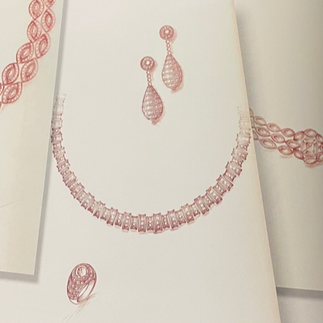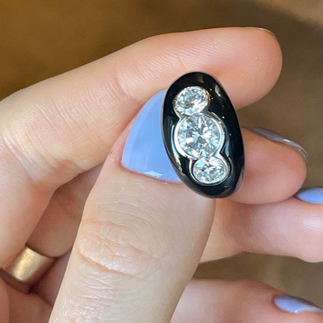Faraone: The story behind the brand
- CUFLBS
- Nov 24, 2021
- 5 min read
Updated: Nov 25, 2021
The nineteenth-century Florentine jewellery house that transformed into a twenty-first Milanese jewellery and luxury goods auction house. This is its story ...
Faraone was founded 165 years ago in 1856 by the Settepassi family who opened their first jewelry shop in Florence on the Ponte Vecchio. It is here that the family business was able to flourish, benefitting from being set amidst luxurious and cosmopolitan mid-nineteenth century Florence. A decade after first opened, Faraone was soon serving upmarket Italian and international customers that included noble families and film stars for whom jewelry was often custom made.


Temporarily suspended by two World Wars and by the death of founder Raffaele Faraone, it was not until 1945 that Guido Faraone made its twentieth-century mark by unravelling the first ever Milanese boutique in 1945 on the chic street of Via Montenapoleone which has become a hub for luxury goods. The current Faraone address remains on this street today, moving, however, further up the road from number 7 to number 9.

Faraone jewels have been endorsed by members of noble families such as Queen Margherita of Savoy, the Monegasque Royal family (Grace Kelly and her granddaughter Charlotte Casiraghi) and stars of the opera and cinema.

Some of whom included the twentieth-century’s most influential soprano singer Maria Callas, as well as renowned Italian Neorealist actress, Anna Magnani, and American and Swedish film-stars: Ava Gardner and Ingrid Bergman.
Tiffany & Co and Faraone

In 1989 Faraone became Tiffany&Co’s exclusive importer for Italy, signing a partnership agreement that enabled the coexistence of the two brands in the historic store of Via Montenapoleone; transforming it into Tiffany-Faraone. Cesare Settepassi (son of Guido) was appointed Vice-President of Tiffany Europe with the task of developing the New York based brand in Europe.
The coexistence of the two Maisons in Via Montenapoleone continued successfully until 2000 when Tiffany & Co moved (as a result of the building they were based in being sold) to their now current headquarters in Via della Spiga.

Cesare Settepassi stayed working at Tiffany and so temporarily closed Faraone, shutting down its store on Monte Napoleone. It was not until mid-2009 that Cesare Settepassi, having left Tiffany & Co, decided to return to the family business. Alongside his wife and a team of specialists, the Florentine artisan-manager returned to devote himself to his generational family passion: luxurious Italian jewelry.
In his relaunch of the brand, Cesare created the ‘One Of A Kind’ collection that paid homage to the most iconic and, once, most sought-after Faraone designs from the second half of the twentieth century.
The collection name One Of A Kind celebrates the exclusivity that comes with luxury items; especially if we are to define luxury with Vogue’s understanding of “craftsmanship [as] luxury. A product is luxe when it is handmade, tailored for few. Luxury meaning exclusiveness”.Fittingly, luxury jewels are not only ‘one of a kind’ because they are hand-made but also because no gem is ever the same. Gems are always unique. They may be cut or fitted in the same way but ultimately share geographical and geological differences that are, at times, only noticeable to the eye of a gemologist.

In 2011, Cesare Settepassi sold Faraone to a group of Italian investors and Vittoria Bianchi was designated as Faraone’s new CEO. Faraone was moved to the third floor of 9 Via Montenapoleone. As Cesare had done, Bianchi ensured that Faraone’s designs remained loyal to the original, iconic pieces. In the pictures below the deliberate similarities between Cesare’s older Faraone rings (on the left) and Bianchi’s more recent designs (on the right) can be spotted.
In the photos below are some of the magnificent pieces Bianchi designed and added to the One Of A Kind collection. (See: https://faraonegioielli.it/collezioni/one-of-a-kind/)
In 2014 Bianchi launched a new collection: ‘The MonteNapoleone Collection’, that revolved around the F icon of Faraone. A modern-age, more contemporary collection created for a younger clientele. Each jewel within this collection is modular. In other words every jewellery piece has a gold link that can attach to another jewel in order to: elongate earrings, change the colour of the F symbol or even turn a ring into an earring. (See: https://faraonegioielli.it/collezione-via-montenapoleone/).


In 2016, Bianchi transformed Faraone into an auction house, whilst continuing to sell Faraone jewels in the showroom and also online.
Bianchi’s inspiration to develop Faraone into an auction house stemmed from receiving multiple clients who would inquire which auction houses they could entrust their inherited, vintage jewels with. Pieces that are nowadays no longer truly suitable for everyday accessories; unless worn by a member of the royal family of course.

When Christie’s and Sotheby’s left Milan in 2016, Bianchi saw an opportunity and seized it. This was the perfect moment to launch Faraone Casa D’Aste.
The first auction was held on May 2016 at the Four Seasons Hotel. It was in this auction that Queen Margherita of Savoy’s diamond necklace was sold.

Queen Margherita of Savoy’s rivière diamond necklace consisted of 38 cushion-cut and old-cut diamonds that weighed about 55ct and were set in rose gold and silver. The necklace was paired with diamond earrings, also set in rose gold and silver, that weighed approximately 5.30ct.

The diamond necklace and earring set was sold at the May 2016 Auction for a total of €224,775 (including buyer’s premium)

Another marvellous piece sold by Faraone (in May 2018) was a sapphire ring (pictured on the left). The cushion cut Kashmir sapphire weighed approximately 9ct. Whereas its encircling brilliant and baguette cut diamonds weighed approximately 1ct.
The ring was sold for a total of €633,850 (including buyer’s premium)
In this day and age, when vintage or used luxury items are mainly sold via e-commerce platforms, it is refreshing for buyers to be able to see items first-hand, at auction houses such as Faraone, before placing a bid for them. Auction house clients are hence more likely to be satisfied with their purchased items than those who buy them via online platforms without ever seeing them.
Sellers also benefit from selling via auction houses rather than through e-commerce platforms. Since the selling price at auction only increases or, worst-case scenario, remains at its starting price. Whereas the selling price on e-commerce apps tends to decrease since buyers are able to negotiate the prices down.
Even if prices may increase at auction, buyers are still better off purchasing items at auction rather than in second-hand online and in-store shops. Since a vast majority of second-hand stores buy their products at auction before then doubling the retail price.
Amongst the 50 Gucci bags Faraone has on auction this year, over fifteen of them are crocodile. These handbags share an incredible starting price of only €500. Meanwhile, most second-hand luxury stores start from €5000 for Gucci crocodile bags.
Faraone’s next auction will be held on 30 November 2021. To view the pieces at auction for the 30 November live auction select the left catalogue named ‘GIOIELLI E OROLOGI DEL XX SECOLO’ on the following link: www.faraonecasadaste.it
On a more personal note, I am interning at this Milanese jewellery and luxury goods auction house as part of my Year Abroad.
Pictured below to the left I am wearing a topaz demi-parure that consists of a contrariè tubogas bracelet with matching earrings. This set is mounted in 18 carat yellow gold and also contains brilliant cut diamonds that weigh approximately 1,60 carats.
The middle picture is of an 18 carat red gold clip and bracelet adorned with coral flower decorations and a shell-like design.
The picture to the far right shows an 18 carat yellow gold semi-rigid necklace that is embellished with brilliant cut diamonds that weigh approximately 1,20 carat
Giacinta McNaught-Davis
Industry Trends Director
Cambridge University Fashion & Luxury Business Society






















Comments